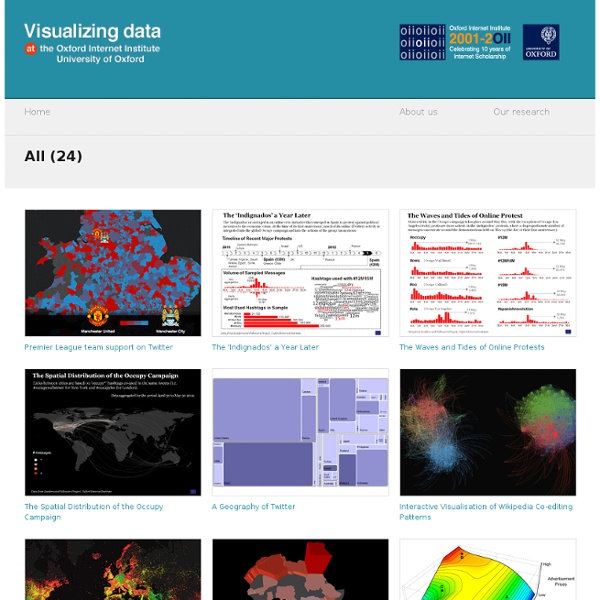



Quick Guide to Social Network Analysis « SplinterNet The last few years have seen the adoption of social networking increase rapidly. From Facebook to Twitter, LinkedIn to Flickr – there is a social network for just about anything. As the revolution of social networking continues unabated, there comes a growing need to explore patterns within the networks – a process called social network analysis (SNA) Previously, the world of social network analysis could only be accessed with a bit of computing knowledge. However, an open source programme called Nodexl has changed that by bringing some of the important metrics used to understand a network, and the ability to create impressive network graphs, into Excel. Nodexl makes understanding a social network graph easy for anyone who can navigate around a spreadsheet. The people that can begin to make use of network graphs range from marketers to activists – and I imagine they are now a staple of any well equipped social media political campaign. There are two basic components of a social graph:
Making data analytics work for you--instead of the other way around Does your data have a purpose? If not, you’re spinning your wheels. Here’s how to discover one and then translate it into action. The data-analytics revolution now under way has the potential to transform how companies organize, operate, manage talent, and create value. But that’s also a mistake. This article describes eight critical elements contributing to clarity of purpose and an ability to act. After all, performance—not pristine data sets, interesting patterns, or killer algorithms—is ultimately the point. ‘Purpose-driven’ data “Better performance” will mean different things to different companies. Ask the right questions The precise question your organization should ask depends on your best-informed priorities. One large financial company erred by embarking on just that sort of open-ended exercise: it sought to collect as much data as possible and then see what turned up. Think really small . . . and very big The smallest edge can make the biggest difference. Embrace taboos
What a Tweet Can Tell You Imagine a tiny little sun, just bursting with heat and light, but trapped inside a hard metal cover with a few holes to let beams of energy stream out from inside. Now imagine there were millions of those little suns, maybe the size of basketballs or tennis balls, all rolling down an assembly line one after another, each with a unique pattern of holes and beams of light streaming out into the world. That's what Twitter is. Inside every unborn tweet you can find infinite potential - someone will be in a place, with social context and they will say something, anything, and give that potential a form. They will say something and it will be instantly available to anyone in the world who's subscribed. Each tweet has more than 30 fields of metadata under the hood; the value populating each of those fields makes up the unique patterns of holes in the metal cover that lets the light out from inside. "One could spend months mining Twitter using @DataSift," said Paul M.
La Cnil ouvre un débat sur le pouvoir des algorithmes Ces formules mathématiques sont au cœur du succès de Netflix, Facebook ou Google. L'autorité en charge du respect de la vie privée lance un cycle de débats publics sur ce thème, en présence de personnalités du numérique. L'algorithme, c'est un peu comme le gluten: beaucoup en parlent, mais peu savent vraiment de quoi il s'agit. D'ici à l'automne 2017, l'autorité indépendante rendra une synthèse publique de l'ensemble des échanges et des enjeux soulevés au cours de l'année. Qu'il s'agisse de l'itinéraire d'un chauffeur Uber, des amis suggérés sur Facebook ou encore des recommandations de films sur Netflix, les algorithmes au cœur de ces décisions ont de nombreux détracteurs. Début décembre, un rapport sur leur régulation a ainsi été commenté par la secrétaire d'État chargée du numérique Axelle Lemaire. La Cnil s'ajoute désormais à cet effort collectif de vulgarisation de l'enjeu algorithmique.
Social Network Analysis Social network analysis [SNA] is the mapping and measuring of relationships and flows between people, groups, organizations, computers, URLs, and other connected information/knowledge entities. The nodes in the network are the people and groups while the links show relationships or flows between the nodes. SNA provides both a visual and a mathematical analysis of human relationships. To understand networks and their participants, we evaluate the location and grouping of actors in the network. We look at a social network -- the "Kite Network" above -- developed by David Krackhardt, a leading researcher in social networks. Degree Centrality Social network researchers measure network activity for a node by using the concept of degrees -- the number of direct connections a node has. Betweenness Centrality While Diane has many direct ties, Heather has few direct connections -- fewer than the average in the network. Closeness Centrality Network Centralization Network Reach Network Integration
NodeXL: Network Overview, Discovery and Exploration for Excel INSNA home page @insna.org